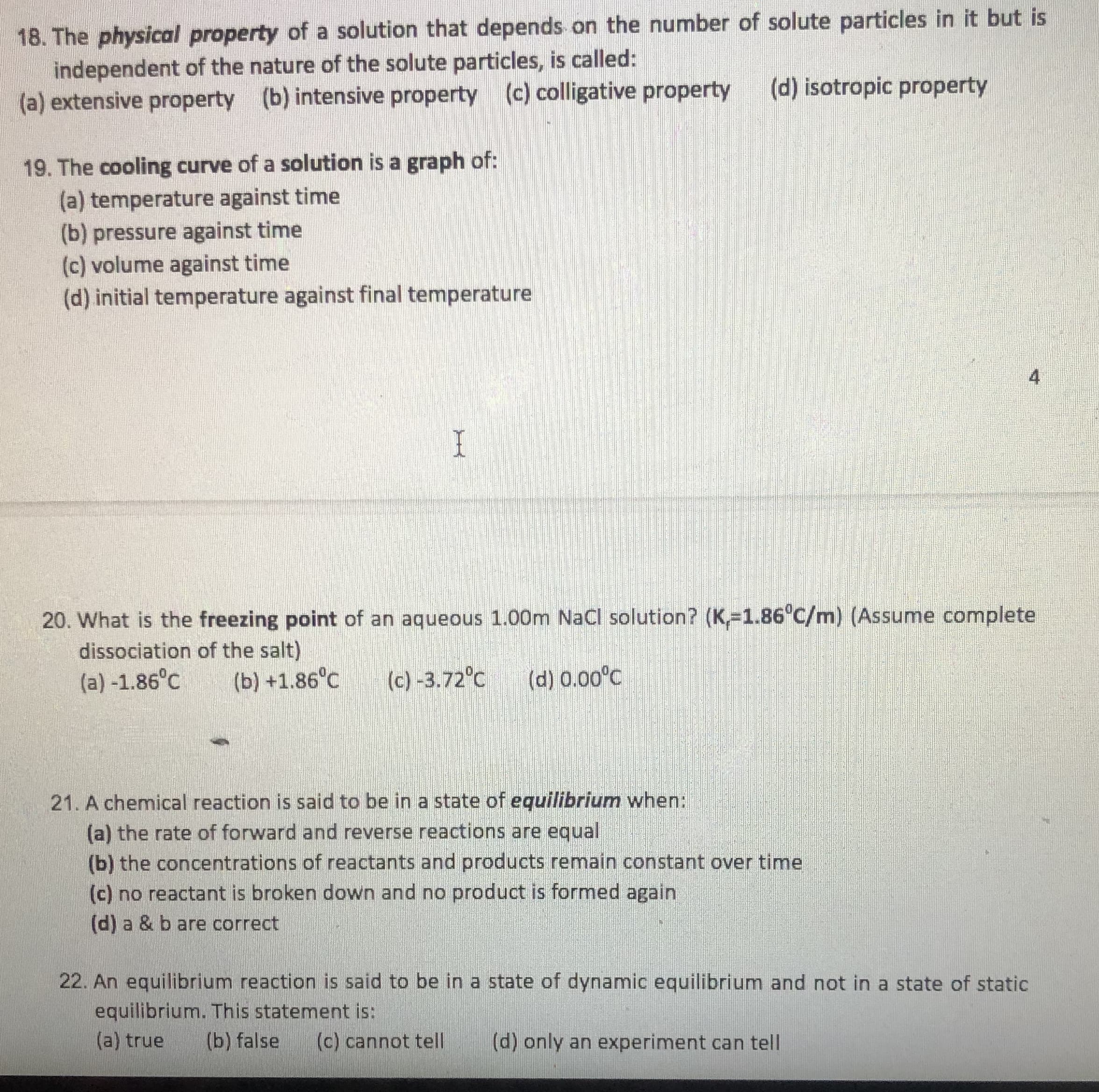18. The physical property of a solution that depends on the number of solute particles in it but is independent of the nature of the solute particles, is called: (a) extensive property (b) intensive property (c) colligative property (d) isotropic property 19. The cooling curve of a solution is a graph of: (a) temperature against time (b) pressure against time (c) volume against time (d) initial temperature against final temperature 20. What is the freezing point of an aqueous 1.00m NaCl solution? (K,-1.86°C/m) (Assume complete dissociation of the salt) (a) -1.86°C (b) +1.86°C (c) -3.72°C (d) 0.00°C 21. A chemical reaction is said to be in a state of equilibrium when: (a) the rate of forward and reverse reactions are equal (b) the concentrations of reactants and products remain constant over time (c) no reactant is broken down and no product is formed again (d) a & b are correct 22. An equilibrium reaction is said to be in a state of dynamic equilibrium and not in a state of static equilibrium. This statement is: (a) true (b) false (c) cannot tell (d) only an experiment can tell 4.
18. The physical property of a solution that depends on the number of solute particles in it but is independent of the nature of the solute particles, is called: (a) extensive property (b) intensive property (c) colligative property (d) isotropic property 19. The cooling curve of a solution is a graph of: (a) temperature against time (b) pressure against time (c) volume against time (d) initial temperature against final temperature 20. What is the freezing point of an aqueous 1.00m NaCl solution? (K,-1.86°C/m) (Assume complete dissociation of the salt) (a) -1.86°C (b) +1.86°C (c) -3.72°C (d) 0.00°C 21. A chemical reaction is said to be in a state of equilibrium when: (a) the rate of forward and reverse reactions are equal (b) the concentrations of reactants and products remain constant over time (c) no reactant is broken down and no product is formed again (d) a & b are correct 22. An equilibrium reaction is said to be in a state of dynamic equilibrium and not in a state of static equilibrium. This statement is: (a) true (b) false (c) cannot tell (d) only an experiment can tell 4.
Chemistry: An Atoms First Approach
2nd Edition
ISBN:9781305079243
Author:Steven S. Zumdahl, Susan A. Zumdahl
Publisher:Steven S. Zumdahl, Susan A. Zumdahl
Chapter10: Properties Of Solutions
Section: Chapter Questions
Problem 7RQ
Related questions
Question

Transcribed Image Text:18. The physical property of a solution that depends on the number of solute particles in it but is
independent of the nature of the solute particles, is called:
(a) extensive property (b) intensive property
(c) colligative property
(d) isotropic property
19. The cooling curve of a solution is a graph of:
(a) temperature against time
(b) pressure against time
(c) volume against time
(d) initial temperature against final temperature
20. What is the freezing point of an aqueous 1.00m NaCl solution? (K,-1.86°C/m) (Assume complete
dissociation of the salt)
(a) -1.86°C
(b) +1.86°C
(c) -3.72°C
(d) 0.00°C
21. A chemical reaction is said to be in a state of equilibrium when:
(a) the rate of forward and reverse reactions are equal
(b) the concentrations of reactants and products remain constant over time
(c) no reactant is broken down and no product is formed again
(d) a & b are correct
22. An equilibrium reaction is said to be in a state of dynamic equilibrium and not in a state of static
equilibrium. This statement is:
(a) true
(b) false
(c) cannot tell
(d) only an experiment can tell
4.
Expert Solution
This question has been solved!
Explore an expertly crafted, step-by-step solution for a thorough understanding of key concepts.
This is a popular solution!
Trending now
This is a popular solution!
Step by step
Solved in 5 steps

Recommended textbooks for you

Chemistry: An Atoms First Approach
Chemistry
ISBN:
9781305079243
Author:
Steven S. Zumdahl, Susan A. Zumdahl
Publisher:
Cengage Learning


Chemistry
Chemistry
ISBN:
9781305957404
Author:
Steven S. Zumdahl, Susan A. Zumdahl, Donald J. DeCoste
Publisher:
Cengage Learning

Chemistry: An Atoms First Approach
Chemistry
ISBN:
9781305079243
Author:
Steven S. Zumdahl, Susan A. Zumdahl
Publisher:
Cengage Learning


Chemistry
Chemistry
ISBN:
9781305957404
Author:
Steven S. Zumdahl, Susan A. Zumdahl, Donald J. DeCoste
Publisher:
Cengage Learning

Principles of Modern Chemistry
Chemistry
ISBN:
9781305079113
Author:
David W. Oxtoby, H. Pat Gillis, Laurie J. Butler
Publisher:
Cengage Learning


Physical Chemistry
Chemistry
ISBN:
9781133958437
Author:
Ball, David W. (david Warren), BAER, Tomas
Publisher:
Wadsworth Cengage Learning,